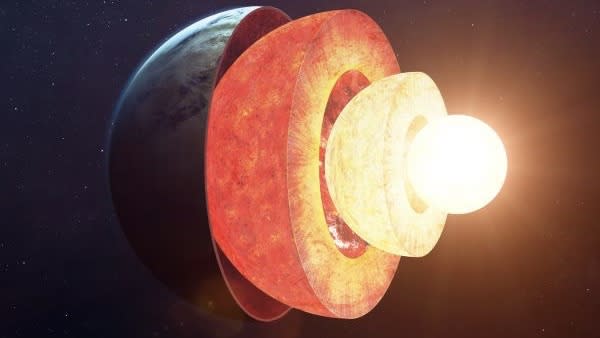Swirls of liquid iron may be trapped inside Earth's 'solid' core

Earth's solid inner core may not be solid after all — at least not all the way through. Instead, it’s a hodgepodge patchwork of solid and liquid that reaches all the way to the center.
New research based on the faint echoes of earthquake waves bouncing back to Earth's surface from the depths of the planet suggests that the inner core is more varied than previously appreciated. The findings indicate that the inner core, which grows about a millimeter (0.04 inch) each year as the liquid outer core solidifies, may have grown faster during earlier times in Earth's history. What's more, there may be swirls of liquid iron trapped inside the solid core, study senior author Keith Koper, a seismologist at the University of Utah, said in a statement.
"A long time ago the inner core grew really fast," Koper said. "It reached an equilibrium, and then it started to grow much more slowly. Not all of the iron became solid, so some liquid iron could be trapped inside."
Related: Earth's mysterious innermost core is a 400-mile-wide metallic ball
Earth's inner core is a solid ball of mostly iron and nickel. Measuring about 1,520 miles (2,440 kilometers), this inner core spins inside the outer core, an ocean of molten iron and nickel about 1,400 miles (2,260 km) thick. The churn of the metal at Earth's center is what creates the planet's magnetic field. Over time, the outer core has gradually crystallized, but scientists know little about how quickly this process has occurred, which also raises questions about the state of Earth's magnetic field over time.
There is no way to access the core directly, so Koper and his team used data from 20 seismometers set up to measure earthquake waves and monitor for nuclear-weapons testing. They focused on waves triggered by earthquakes of magnitude 5.7 or above, which are large enough to vibrate down to the inner core, sending a faint echo back to the seismometer. There were 2,455 such earthquakes in the dataset.
"This signal that comes back from the inner core is really tiny," Koper said. "The size is about on the order of a nanometer. What we're doing is looking for a needle in a haystack. So these baby echoes and reflections are very hard to see."
The key finding, reported July 5 in the journal Nature, was that the core's composition was "inhomogeneous," or varied. In other words, the inner core didn't solidify smoothly and is made up of a patchwork of different textures.
Related Stories:
— Earth's inner core may be slowing down compared to the rest of the planet
— How has Earth's core stayed as hot as the sun's surface for billions of years?
— Mysterious new substance possibly discovered inside Earth's core
"For the first time we confirmed that this kind of inhomogeneity is everywhere inside the inner core," Guanning Pang, a postdoctoral researcher at Cornell University who conducted the research as a doctoral student at the University of Utah, said in the statement.
Seismic waves scatter more the deeper they penetrate the core, Koper said, indicating an increasing amount of variability closer to Earth's center. This could be related to the changing rate of solidification of the core over time, he added.
